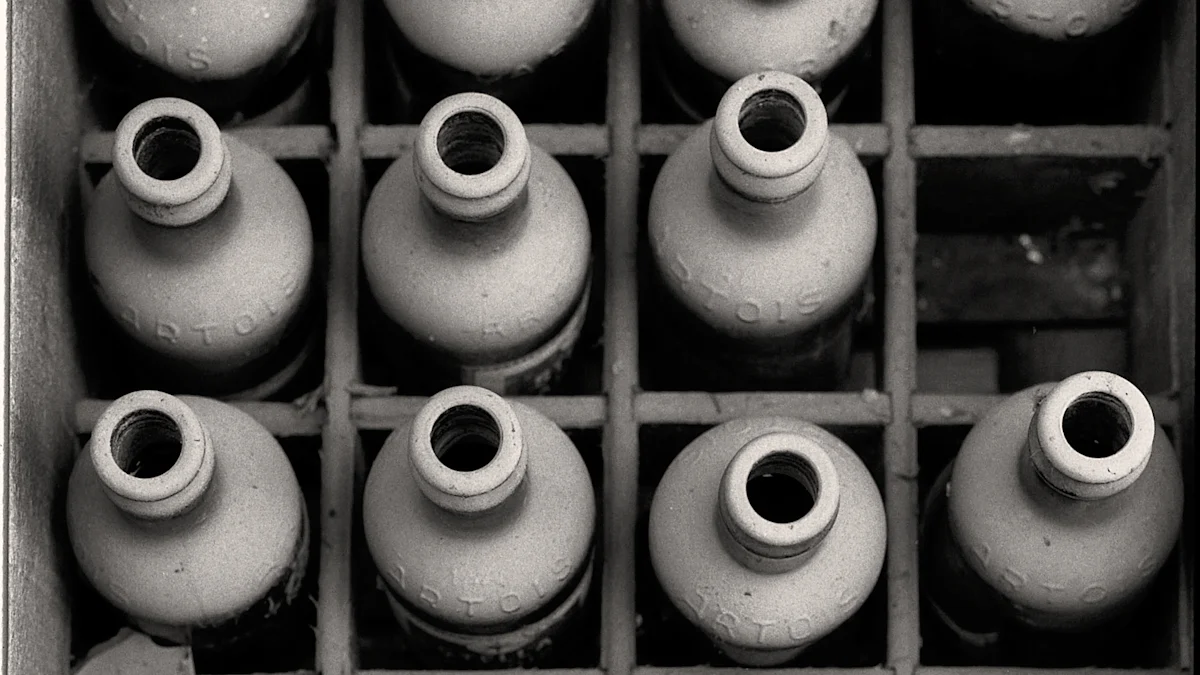
Silicon Carbide (SiC) crystal suppliers offer a diverse range of products and services that cater to various industries. These suppliers provide high-quality SiC crystals, which are essential in power electronics, automotive, and telecommunications sectors. Understanding what each supplier offers is crucial for making informed decisions. The market for SiC crystals, particularly the 4H-SiC substrate, continues to grow, driven by its applications in high-performance electronics. As the demand increases, selecting the right supplier becomes vital for businesses aiming to leverage the benefits of SiC technology.
Key Takeaways
- SiC crystals are vital in various industries, including automotive, electronics, and telecommunications, due to their exceptional properties like high thermal conductivity and electric field breakdown strength.
- Choosing the right SiC crystal supplier is crucial; consider factors such as quality assurance, cost-effectiveness, and customer support to ensure reliable partnerships.
- Customization options, including size, shape, doping, and purity levels, allow businesses to optimize SiC crystals for specific applications, enhancing performance and efficiency.
- Monocrystalline SiC offers superior performance for high-efficiency applications, while polycrystalline SiC provides a cost-effective solution for budget-sensitive projects.
- Suppliers adhere to strict industry standards and implement robust quality assurance processes to ensure the reliability and performance of SiC crystals in demanding environments.
- Technological innovations in SiC crystal production, such as larger wafers, are essential for meeting the growing demand for high-performance electronics.
- Investing in SiC technology can significantly improve energy management and reduce heat generation in applications like electric vehicles and renewable energy systems.
Overview of SiC Crystals

What are SiC Crystals?
Silicon Carbide (SiC) crystals are a compound of silicon and carbon, known for their exceptional properties. These crystals exhibit high thermal conductivity, making them ideal for applications that require efficient heat dissipation. SiC crystals also possess high electric field breakdown strength, allowing them to function effectively in high-voltage environments. Their ability to withstand high temperatures and resist radiation makes them suitable for use in demanding conditions.
SiC crystals come in various forms, including monocrystalline and polycrystalline structures. Monocrystalline SiC, often used in semiconductor applications, provides superior performance due to its uniform crystal structure. Polycrystalline SiC, on the other hand, is typically used in applications where cost-effectiveness is a priority. The unique properties of SiC crystals make them indispensable in modern technology.
Applications of SiC Crystals
SiC crystals find applications across a wide range of industries due to their remarkable characteristics. In the electronics sector, they are crucial for manufacturing power devices that operate efficiently at high frequencies and temperatures. SiC’s high saturation electron mobility enhances the performance of these devices, making them suitable for high-power applications.
In optoelectronics, SiC crystals serve as substrates for light-emitting diodes (LEDs) and other optical devices. Their ability to function in high-temperature environments ensures reliability and longevity in these applications. Additionally, SiC crystals are used in sensors and detectors, where their high thermal stability and resistance to radiation are advantageous.
The automotive industry also benefits from SiC technology. SiC crystals are used in electric vehicles to improve the efficiency of power electronics, contributing to better energy management and reduced heat generation. As the demand for high-performance electronics continues to grow, the role of SiC crystals in advanced semiconductor applications becomes increasingly significant.
Key Offerings of SiC Crystal Suppliers
Types of SiC Crystals
Monocrystalline SiC
Monocrystalline SiC crystals stand out for their uniform crystal structure, which enhances their performance in semiconductor applications. These crystals are pivotal in the production of high-efficiency chips and power electronics systems. Their ability to handle extreme conditions makes them indispensable in industries such as automotive and aerospace. The demand for monocrystalline SiC continues to rise as manufacturers seek materials that offer superior thermal conductivity and electric field breakdown strength.
Polycrystalline SiC
Polycrystalline SiC crystals, while not as uniform as their monocrystalline counterparts, offer a cost-effective solution for various applications. These crystals are often used in scenarios where budget constraints are a priority, yet performance cannot be compromised. Polycrystalline SiC finds its place in applications like solar inverters and communication technologies, where its ability to withstand high temperatures and resist radiation proves beneficial.
Customization Options
Size and Shape Customization
SiC crystal suppliers provide extensive customization options to meet specific industry needs. Customers can request SiC crystals in various sizes and shapes, tailored to fit unique applications. This flexibility allows manufacturers to optimize their products for better performance and efficiency. For instance, larger SiC wafers produced in advanced furnaces offer higher yields and fewer defects, making them attractive to semiconductor manufacturers.
Doping and Purity Levels
Suppliers also offer customization in terms of doping and purity levels. Adjusting these parameters can significantly impact the electrical properties of SiC crystals, making them suitable for a wide range of applications. High purity levels ensure that the crystals perform reliably in demanding environments, such as high-voltage and high-frequency settings. This level of customization enables businesses to leverage SiC technology effectively across different sectors.
Quality and Standards
Industry Standards Compliance
SiC crystal suppliers adhere to stringent industry standards to ensure the quality and reliability of their products. Compliance with these standards guarantees that the crystals meet the necessary specifications for use in critical applications. This commitment to quality is essential for maintaining the performance and safety of devices that rely on SiC technology.
Quality Assurance Processes
Robust quality assurance processes are in place to monitor the production of SiC crystals. These processes involve rigorous testing and inspection to identify and rectify any defects, such as stacking faults and dislocations. By maintaining high-quality standards, suppliers ensure that their SiC crystals deliver consistent performance and reliability, which is crucial for industries that depend on these advanced materials.
Comparison of Major SiC Crystal Suppliers

Supplier Profiles
LSP Industrial Ceramics, Inc.
LSP Industrial Ceramics, Inc. stands as a prominent player in the silicon carbide industry. They specialize in producing high-quality SiC crystals that cater to various sectors, including automotive and aerospace. Their products are known for their durability and ability to withstand extreme conditions, making them a preferred choice for industries that demand reliability.
C-Mac International, LLC
C-Mac International, LLC offers a diverse range of SiC crystal products. They focus on providing solutions that meet the specific needs of their clients. Their expertise in customization allows them to deliver SiC crystals tailored to unique applications, ensuring optimal performance and efficiency. This adaptability makes them a valuable partner for businesses seeking specialized SiC solutions.
Stanford Advanced Materials
Stanford Advanced Materials excels in delivering high-quality SiC crystal substrates at competitive prices. Their commitment to quality and affordability has earned them a strong reputation in the market. They serve a wide array of industries, including power electronics and telecommunications, where the demand for efficient and reliable materials is ever-growing.
Semicorex
Semicorex specializes in 3C-SiC wafer substrates, offering products that are integral to semiconductor manufacturing. Their focus on technological advancements ensures that they remain at the forefront of the industry. By providing cutting-edge SiC solutions, Semicorex supports the development of next-generation electronic devices.
Unique Selling Points
Technological Innovations
SiC crystal suppliers continuously invest in technological innovations to enhance their product offerings. These advancements include the development of larger SiC wafers, which provide higher yields and fewer defects. Such innovations are crucial for industries like automotive and renewable energy, where efficiency and reliability are paramount.
Market Reputation
The reputation of SiC crystal suppliers plays a significant role in their success. Companies like LSP Industrial Ceramics, Inc. and Stanford Advanced Materials have established themselves as leaders in the market by consistently delivering high-quality products. Their commitment to excellence and customer satisfaction has solidified their standing in the industry.
Factors to Consider When Choosing a SiC Crystal Supplier
Selecting the right SiC crystal supplier involves evaluating several critical factors. These considerations ensure that businesses receive high-quality materials that meet their specific needs and contribute to their success in various applications.
Quality and Reliability
Quality assurance stands as a pivotal factor when choosing a supplier. Reliable suppliers implement rigorous quality assurance processes to ensure their SiC crystals meet industry standards. These processes involve thorough testing and inspection to identify any defects, such as stacking faults and dislocations. By maintaining high-quality standards, suppliers guarantee that their SiC crystals deliver consistent performance and reliability. This is crucial for industries that depend on these advanced materials, especially in high-temperature, high-voltage, and high-frequency environments.
Cost and Value
Cost and value play significant roles in the decision-making process. While price is an important consideration, it should not overshadow the value offered by the supplier. Businesses must assess the overall value proposition, which includes the quality of the SiC crystals, customization options, and the supplier’s ability to meet delivery timelines. A supplier offering competitive pricing without compromising on quality provides better value. This balance ensures that businesses can optimize their investments in SiC technology.
Customer Support
Customer support is another essential factor to consider. A supplier with excellent customer support can address any issues promptly and provide guidance on product selection and application. This support includes technical assistance, troubleshooting, and after-sales service. Collaborating with a supplier that prioritizes customer satisfaction ensures a smooth and efficient procurement process. It also fosters a long-term partnership, which is beneficial for businesses looking to scale their operations and adapt to changing market demands.
SiC crystal suppliers play a pivotal role in advancing technology across various industries. They offer diverse products and customization options, ensuring that businesses receive materials tailored to their specific needs. Selecting the right supplier is crucial for leveraging the benefits of SiC technology, especially as demand continues to rise. Companies must consider quality, cost, and customer support when making their choice. By doing so, they can secure a reliable partner that contributes to their success in high-performance applications.
FAQ
What are the fundamentals of SiC Wafers?
Silicon Carbide (SiC) crystal substrates offer a range of benefits that make them essential in modern technology. They find applications in electronics, optoelectronics, power devices, sensors, and detectors. As industries continue to advance, SiC will become even more important. Its ability to handle extreme conditions and deliver reliable performance ensures that SiC will play a key role in future technologies.
How can SiC crystal substrates benefit applications?
SiC crystal substrates are advanced semiconductor materials with unique properties. These substrates have become popular because they perform better than traditional silicon in many areas. SiC has a structure with alternating layers of silicon and carbon atoms. This structure gives SiC its strength and versatility, making it perfect for use in electronics, optoelectronics, sensors, and detectors.
How can SiC crystal products be customized?
Customized SiC crystal products can be made to meet customers’ particular requirements and specifications. Suppliers offer extensive customization options, including size, shape, doping, and purity levels. This flexibility allows manufacturers to optimize their products for better performance and efficiency in various applications.
Why is SiC preferred over traditional silicon in some applications?
SiC offers superior thermal conductivity, high electric field breakdown strength, and excellent thermal stability compared to traditional silicon. These properties make SiC ideal for high-power, high-temperature, and high-frequency applications. Industries such as automotive, aerospace, and telecommunications benefit significantly from SiC’s advanced capabilities.
What industries benefit most from SiC technology?
Several industries benefit from SiC technology, including automotive, aerospace, telecommunications, and renewable energy. In the automotive sector, SiC improves the efficiency of power electronics in electric vehicles. Aerospace applications leverage SiC’s ability to withstand extreme conditions. Telecommunications and renewable energy sectors utilize SiC for its high-performance characteristics in power devices and sensors.
How do SiC crystal suppliers ensure product quality?
SiC crystal suppliers adhere to stringent industry standards and implement robust quality assurance processes. These processes involve rigorous testing and inspection to identify and rectify any defects. By maintaining high-quality standards, suppliers ensure that their SiC crystals deliver consistent performance and reliability, which is crucial for industries that depend on these advanced materials.
What are the key factors to consider when choosing a SiC crystal supplier?
When selecting a SiC crystal supplier, businesses should consider quality and reliability, cost and value, and customer support. Reliable suppliers implement rigorous quality assurance processes and offer competitive pricing without compromising on quality. Excellent customer support, including technical assistance and after-sales service, ensures a smooth procurement process and fosters long-term partnerships.
Can SiC crystals be used in high-temperature environments?
Yes, SiC crystals can be used in high-temperature environments due to their exceptional thermal stability. Their ability to withstand high temperatures makes them suitable for demanding applications in industries such as aerospace and power electronics. This property ensures reliability and longevity in challenging conditions.
What customization options are available for SiC crystals?
SiC crystal suppliers offer various customization options, including size and shape customization, as well as doping and purity levels. These options allow businesses to tailor SiC crystals to their specific needs, optimizing performance and efficiency for different applications. Customization ensures that SiC technology can be effectively leveraged across diverse sectors.
How does SiC technology contribute to renewable energy solutions?
SiC technology contributes to renewable energy solutions by enhancing the efficiency and reliability of power devices used in solar inverters and wind turbines. SiC’s high thermal conductivity and electric field breakdown strength improve the performance of these devices, enabling better energy management and reduced heat generation. This makes SiC an integral component in advancing sustainable energy technologies.